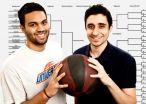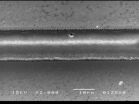(Press-News.org) CHAMPAIGN, Ill. — Think picking all the top-seeded teams as the Final Four in your March Madness bracket is your best bet for winning the office pool? Think again.
According to an operations research analysis model developed by Sheldon H. Jacobson, a professor of computer science and the director of the simulation and optimization laboratory at the University of Illinois, you're better off picking a combination of two top-seeded teams, a No. 2 seed and a No. 3 seed.
"There are patterns that exist in the seeds," Jacobson says. "As much as we like to believe otherwise, the fact of the matter is that we've uncovered a model that captures this pattern. As a result of that, in spite of what we emotionally feel about teams or who's going to win, the reality is that the numbers trump all of these things," Jacobson said. "It's more likely to be 1, 1, 2, 3 in the Final Four than four No. 1's."
Jacobson's model is unique in that it prognosticates not based on who the teams are, but on the seeds they hold. He describes his model in a forthcoming paper in the journal Omega with co-authors Alex Nikolaev, of the University of Buffalo; Adrian Lee, of CITERI (Central Illinois Technology and Education Research Institute); and Douglas King, a graduate student at Illinois.
Jacobson has also integrated the model into a user-friendly website to help March Madness fans determine the relative probability of their chosen team combinations appearing in the final rounds of the NCAA men's basketball tournament.
A number of websites offer assistance to budding bracketologists, such as
game-by-game probabilities of certain match-ups or determining the spread on a given team reaching a particular point in the tournament. Jacobson's website is the only one to look at collective groups of seeds within the brackets.
"What we do is use the power of analytics to uncover trends in 'bracketology.' It really is a mathematical science," he said. "What our model enables us to do is look at the likelihood or probability that a certain set of seed combinations will occur as we advance deeper into the tournament."
Jacobson's team applied a statistical method called goodness-of-fit testing to NCAA tournament data from 1985 to 2010, identifying patterns in seed distribution in the Elite Eight, Final Four and national championship rounds. They found that the seeds themselves exhibit certain statistical patterns, independent of the team. They then fit the pattern to a stochastic model they can use to assess probabilities and odds.
Two computer science undergraduates, Ammar Rizwan and Emon Dai, built the website bracketodds.cs.illinois.edu based on Jacobson's model. The publicly accessible website will be up through the entire tournament. Users can evaluate their brackets and also can compare relative likelihood of two sets of seed combinations.
"For each of the rounds that we have available, you could put in what you have so far and even compare it to other possible sets," Rizwan said.
For example, the probability of the Final Four comprising the four top-seeded teams is 0.026, or once every 39 years. Meanwhile, the probability of a Final Four of all No. 16 seeds – the lowest-seeded teams in the tournament – is so small that it has a frequency of happening once every eight hundred trillion years. (The Milky Way contains an estimated one hundred billion stars.)
"Basically, if every star was given a year, the years it would take for this to occur is 8,000 times all the stars in the galaxy," Jacobson said. "It gives you perspective."
However, sets with long odds do happen. The most unlikely combination in the 26 years studied occurred in 2000, with a Final Four seed combination of 1, 5, 8 and 8. But such a bracket is only predicted to happen once every 32,000 years, so those filling out brackets at home shouldn't hope for a repeat.
What amateur bracketologists can be confident of is upsets. For even the most probable Final Four combination of 1,1,2,3 to occur, two top-seeded schools have to lose.
"In fact, upsets occur with great frequency and great predictability. If you look statistically, there's a certain number of upsets that occur in each round. We just don't know which team they're going to be or when they're going to occur," Jacobson said.
After the 2011 tournament, and in years to come, Jacobson will integrate the new data into the model to continually refine its prediction power. For 2012, Jacobson, Rizwan and Dai hope to integrate a comparative probability feature into the website to allow users to calculate, for example, the probability of a particular set of Final Four seeds if the Elite Eight seeds are given.
Until then, users can find out how likely their picks really are, and compare them against friends' picks – or even sports commentators'.
"We're not here specifically to say 'Syracuse is going to beat Kentucky in the Elite Eight.' What we're saying is that the seed numbers have patterns," Jacobson said. "A 1, 1, 2, 3 is the most likely Final Four. I don't know which two 1's, I don't know which No. 2 and I don't know which No. 3. But I can tell you that if you want to go purely with the odds, choose a Final Four with seeds 1, 1, 2, 3."
INFORMATION:
Editor's note: To reach Sheldon Jacobson, call 217- 244-7275 or 217-333-3328; e-mail shj@illinois.edu. Visit http://bracketodds.cs.illinois.edu to see the model in action.
Real March Madness is relying on seedings to determine Final 4
2011-03-09
ELSE PRESS RELEASES FROM THIS DATE:
It's all in a name: 'Global warming' vs. 'climate change'
2011-03-09
ANN ARBOR, Mich.---Many Americans are skeptical about whether the world's weather is changing, but apparently the degree of skepticism varies systematically depending on what that change is called.
According to a University of Michigan study published in the forthcoming issue of Public Opinion Quarterly, more people believe in "climate change" than in "global warming."
"Wording matters," said Jonathon Schuldt, the lead author of the article about the study and a doctoral candidate in the U-M Department of Psychology.
Schuldt co-authored the study with U-M psychologists ...
Ultrafast laser 'scribing' technique to cut cost, hike efficiency of solar cells
2011-03-09
WEST LAFAYETTE, Ind. - Researchers are developing a technology that aims to help make solar cells more affordable and efficient by using a new manufacturing method that employs an ultrafast pulsing laser.
The innovation may help to overcome two major obstacles that hinder widespread adoption of solar cells: the need to reduce manufacturing costs and increase the efficiency of converting sunlight into an electric current, said Yung Shin, a professor of mechanical engineering and director of Purdue University's Center for Laser-Based Manufacturing.
Critical to both are ...
Oldest known wild bird in US returns to Midway to raise chick
2011-03-09
MIDWAY ATOLL — The oldest known U.S. wild bird – a coyly conservative 60 -- is a new mother.
The bird, a Laysan albatross named Wisdom, was spotted a few weeks ago with a chick by John Klavitter, a U.S. Fish and Wildlife Service biologist and the deputy manager of the Midway Atoll National Wildlife Refuge.
The bird has sported and worn out 5 bird bands since she was first banded by U.S. Geological Survey scientist Chandler Robbins in 1956 as she incubated an egg. Chandler rediscovered Wisdom in 2001. In 1956, he estimated Wisdom to be at least 5 years old then since ...
NYSCF – Robertson investigator publishes research to better understand pluripotent stem cells
2011-03-09
NEW YORK CITY (March 7, 2011)— Paul Tesar, PhD, of Case Western Reserve University, a member of the inaugural class of The New York Stem Cell Foundation – Robertson Investigators, published his research on the ability to isolate epiblast stem cells from preimplantation mouse embryos. This research enhances our understanding of the many forms of pluriportent stem cells that scientists use for researching so many debilitating diseases.
"I think that this paper will change the way people think about what human ES cells represent from a developmental perspective," said Dr. ...
ADAM-12 gene could hold key to cancer, arthritis and cardiac treatments
2011-03-09
COLUMBIA, Mo. ADAM-12 is not only the name of a 1970's television police drama – it's also the gene that University of Missouri researchers believe could be an important element in the fight against cancer, arthritis, and cardiac hypertrophy, or thickening of the heart's walls.
Alpana Ray, research associate professor in the MU College of Veterinary Medicine, and a team of researchers including Bimal Ray, professor of Veterinary Pathobiology, have been studying the ADAM family of genes for several years. Alpana Ray's latest publication in the Proceedings of the National ...
Colonoscopy linked to decrease in colorectal cancer deaths, but many more could have been prevented
2011-03-09
OAK BROOK, Ill. – March 8, 2011 – In recognition of National Colorectal Cancer Awareness Month during March, GIE: Gastrointestinal Endoscopy has published a special issue for March on colonoscopy and colorectal cancer. The issue includes a study showing that colonoscopy has prevented a substantial number of deaths from colorectal cancer and that many more could have been prevented with more widespread use. The analysis reports that approximately 13,800 to 22,000 colorectal cancer deaths could have been prevented in 2005, whereas 7,300 to 11,700 were actually prevented through ...
When work calls: Study shows that receiving work-related contact at home takes greater toll on women's well-being
2011-03-09
FOR IMMEDIATE RELEASE from the UNIVERSITY OF TORONTO
March 8, 2011
TORONTO, ON – Communication technologies that help people stay connected to the workplace are often seen as solutions to balancing work and family life. A new study, however, suggests there may be a "dark side" to the use of these technologies for workers' health – and these effects seem to differ for women and men.
Using data from a national survey of American workers, University of Toronto researchers asked study participants how often they were contacted outside the workplace by phone, email or text ...
The science behind the cape
2011-03-09
Bethesda, Md. (Mar. 8, 2011) -- What do you have when you line up a martial artist, acrobatic gymnast, police officer, firefighter, NASCAR driver, and NFL running back? "Watson," the IBM super-computer that recently routed humanity's best on Jeopardy might have guessed the answer was "the Village People," to which host Alex Trebek could have replied, "Sorry. The answer we were looking for is 'Batman'." At least that is the correct answer for physiologist E. Paul Zehr.
In a new article, Zehr, a professor at the University of Victoria, Victoria, British Columbia, describes ...
Passive news reports may lead readers to feel they can't find the truth
2011-03-09
COLUMBUS, Ohio – Passive news reporting that doesn't attempt to resolve factual disputes in politics may have detrimental effects on readers, new research suggests.
The study found that people are more likely to doubt their own ability to determine the truth in politics after reading an article that simply lists competing claims without offering any idea of which side is right.
"There are consequences to journalism that just reports what each side says with no fact checking," said Raymond Pingree, author of the study and assistant professor of communication at Ohio ...
Epilepsy-linked memory losss worries more patients than doctors
2011-03-09
COLUMBUS, Ohio – Patients with epilepsy worry more than their physicians do about the patients' potential memory loss accompanying their seizure disorder, according to a recent study.
In a survey, patients with epilepsy as a group ranked memory loss as their second-most important concern on a list of 20 potential medical or social concerns. Memory loss as a concern came in 12th in the frequency of responses among concerns recorded by physicians and nurse practitioners who completed the same survey.
Patients and practitioners agreed overall on three of the top five concerns: ...


